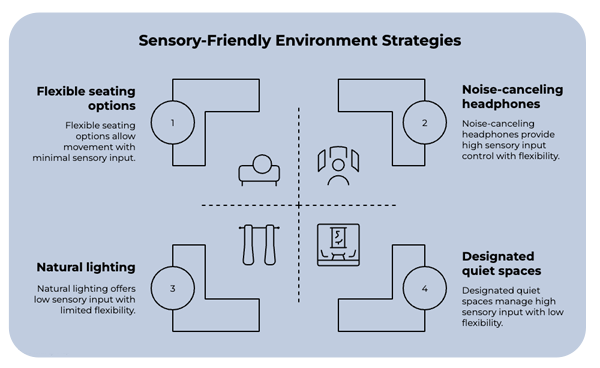
April is World Autism Acceptance Month, a time to embrace the diversity and unique contributions of individuals with autism. This year’s theme, “Celebrate Differences,” emphasizes the importance of moving beyond awareness toward meaningful acceptance. This shift invites mental health professionals and society to see autism as a natural and valuable part of human diversity, celebrating the strengths and perspectives that autistic people bring to our communities. By adopting a neurodiversity-affirming approach, we can foster environments that validate autistic experiences and promote inclusion, ensuring that autistic individuals are valued for their authentic selves.
From the Medical Model to a Neurodiversity-Affirming Approach
The medical model has long been the traditional way that mental health professionals approach autism. Its focus has been on diagnosing perceived deficits and working to help individuals with autism adapt to neurotypical norms. However, professionals who work with the autistic community have observed an important evolution in recent years. A growing neurodiversity-affirming movement emphasizes autism as a natural variation in human neurobiology.
Instead of viewing autism through the lens of what needs to be “fixed,” the neurodiversity perspective values and validates autistic experiences. This approach prioritizes understanding and accommodating inherent autistic traits and fostering environments where autistic individuals can thrive. Here’s what Laurie Guidry had to say about this in her Safer Society training, “Assessment and Treatment of Children and Adolescents on the Autism Spectrum“:
“Look at some of the strengths that result from the differences in brain organization afforded to folks on the Spectrum. There can be the capacity for intense focus, good memory of facts, a good sense of direction, and fascination with maps and routes. They can be hard workers when the job is a good match. They have the ability to see patterns that some of us cannot, good attention to detail, and they can be very honest and loyal.”
While it’s important to celebrate these strengths, it’s equally essential to acknowledge that many autistic individuals face significant challenges in navigating a world designed for neurotypical people. By embracing both perspectives—recognizing strengths while addressing barriers—mental health professionals can create more inclusive and supportive environments for their autistic clients.
Understanding Autistic Communication
Therapists recognize that social interaction and communication differ for autistic individuals. Autistic communication tends to involve a preference for clear, direct language, and conversations centered around specific interests rather than casual small talk. Communication challenges can arise not simply from autistic “deficits” but from the mismatch between autistic and neurotypical communication styles.
Autistic communication encompasses a wide range of methods, including spoken language, gestures, body movements, echolalia (repetition of sounds or phrases), info-dumping (sharing detailed knowledge about a topic), and the use of assistive devices such as text-to-speech tools. Understanding these diverse styles is crucial for fostering meaningful connections with clients. Kim Spence, PhD, shared this thought with us in her recent training, “Evidence-Based Strategies for Treating Individuals with Autism Spectrum Disorder Who Sexually Harm“:
“I think it’s very important that we always value the uniqueness that each of our clients brings to the table. There’s a very famous saying that’s attributed to Dr. Steven Shore, who is on the spectrum, and he said, ‘If you’ve met one person with autism, you’ve met one person with autism.’”

To better support clients who are autistic, therapists can:
- Use direct and literal language
- Avoid vague or open-ended questions; instead, ask specific “Wh” questions (e.g., who, what, where)
- Reframe behaviors such as info-dumping or longer conversational turns as valid ways of sharing excitement and building connections
- Respect preferences for reduced eye contact, which may help regulate sensory input and reduce anxiety
Creating Supportive Environments
An important aspect of autism acceptance is the creation of sensory-friendly spaces. These environments help reduce overwhelming sensory input and create a sense of safety and comfort. Strategies for creating supportive spaces include:
- Thoughtful lighting: Using alternatives to harsh fluorescent lighting, such as natural light or softer lamps
- Sound management: Incorporating soundproofing or offering tools like noise-canceling headphones
- Support for movement needs: Allowing for self-regulating movements and providing flexible seating options
- Quiet spaces: Providing designated areas for stepping away when feeling overwhelmed
- Accommodations: Supporting the use of sensory comfort items
Dr. Spence emphasized the importance of social support in treatment plans, stating, “Every single client that you have who has an autism spectrum disorder, or who you suspect has an autism spectrum disorder, will need some kind of social support. Your treatment should 100% include things that are going to help improve their social interactions with others.”
A Shift in Social Understanding
Broader societal shifts toward autism acceptance are both encouraging and essential. For example, some toy manufacturers now include characters with sunflower lanyards to represent hidden disabilities like autism, promoting diversity and inclusivity in children’s toys. These seemingly small steps play a powerful role in shaping awareness and understanding among younger generations, helping normalize neurodiversity from an early age.
By understanding neurodiversity-affirming concepts and actively working to create more inclusive environments, mental health professionals can provide meaningful support that validates unique experiences.
Resources from Safer Society
As we continue to embrace autism acceptance and celebrate differences, it’s essential that professionals gain the knowledge and skills needed to support autistic individuals effectively. Safer Society is proud to offer resources and training that align with neurodiversity-affirming principles, empowering mental health professionals, educators, and justice system workers to make a meaningful impact. The following Safer Society Continuing Education Center resources provide practical strategies for understanding, supporting, and working with autistic individuals in diverse contexts:
- Assessing, Treating, and Supervising Autistic Adults Who Have Offended Sexually: Presented by Tiffany Looney, this on-demand training helps participants develop an understanding of the neurobiological differences of the autistic brain, the social model of disability, and what it means to be neurodiversity-affirming.
- Autism Spectrum Disorders and Criminal Justice: Presented by Dr. Kim Spence, this on-demand training provides detailed information about autism spectrum disorders and documented case examples that illustrate the consequences facing these clients within the criminal justice system. It also provides practical strategies for identifying characteristics of autism spectrum disorder in non-diagnosed clients.
- Assessment and Treatment of Children and Adolescents on the Autism Spectrum: Presented by Laurie Guidry, PsyD, this on-demand training helps professionals develop a deeper understanding of autism among children and adolescents as a multi-faceted, brain-based disorder and provides guidance on current best practices in psychotherapy assessment and treatment.
- Evidence-Based Strategies for Treating Individuals with Autism Spectrum Disorder Who Sexually Harm: Presented by Dr. Kim Spence, this training addresses the unique challenges faced by individuals with autism spectrum disorder who cause sexual harm. It offers practical guidance on developing intervention strategies tailored to these clients’ specific needs.
- The Criminal Justice System’s Need for Better Understanding of Clients with Autism Spectrum Disorders: This hour-long webinar conversation with Kim Spence, included in our On-Demand Webinar Library Subscription, examines the ways criminal justice systems fall short in ensuring the safety and effective rehabilitation of this vulnerable population.
Additional Resources on Autism
